Earthbag Construction
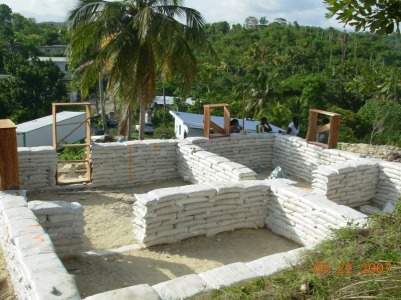
(Taken from Earthbagbuilding.com)Building with earthbags (sometimes called sandbags) is both old and new. Sandbags have long been used, particularly by the military, for creating strong, protective barriers, or for flood control. The same reasons that make them useful for these applications carry over to creating housing. Since the walls are so substantial, they resist all kinds of severe weather (or even bullets) and also stand up to natural calamities such as earthquakes and floods. They can be erected simply and quickly with readily available components, for very little money.
Earthbag building fills a unique niche in the quest for sustainable architecture. The bags can be filled with local, natural materials, which lowers the embodied energy commonly associated with the manufacture and transportation of building materials. The fill material is generally of mineral composition and is not subject to decomposition (even when damp), attractive to vermin, or burnable...in other word it is extremely durable. The fill material is generally completely non-toxic and will not offgas noxious fumes into the building.
Earthbag building fills a unique niche in the quest for sustainable architecture. The bags can be filled with local, natural materials, which lowers the embodied energy commonly associated with the manufacture and transportation of building materials. The fill material is generally of mineral composition and is not subject to decomposition (even when damp), attractive to vermin, or burnable...in other word it is extremely durable. The fill material is generally completely non-toxic and will not offgas noxious fumes into the building.
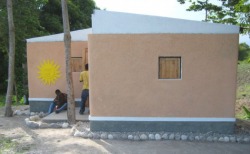
Earthbags have the tremendous advantage of providing either thermal mass or insulation, depending on what the bags are filled with. When filled with soil they provide thermal mass, but when filled with lighter weight materials, such as crushed volcanic stone, perlite, vermiculite, or rice hulls, they provide insulation. The bags can even act as natural non-wicking, somewhat insulated foundations when they are filled with gravel.
Because the earthbags can be stacked in a wide variety of shapes, including domes, they have the potential to virtually eliminate the need for common tensile materials in the structure, especially the wood and steel often used for roofs. This not only saves more energy (and pollution), but also helps save our forests, which are increasingly necessary for sequestering carbon.
Because the earthbags can be stacked in a wide variety of shapes, including domes, they have the potential to virtually eliminate the need for common tensile materials in the structure, especially the wood and steel often used for roofs. This not only saves more energy (and pollution), but also helps save our forests, which are increasingly necessary for sequestering carbon.
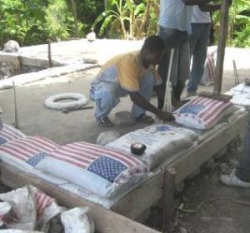
Another aspect of sustainability is found in the economy of this method. The fill material can be literally "dirt cheap," especially if on-site soil is used. The earthbags themselves can often be purchased as misprints or recycled grain sacks, but even when new are not particularly expensive. Burlap bags were traditionally used for this purpose, and they work fine but are subject to rot. Polypropylene bags have superior strength and durability, as long as they are kept away from too much sunlight. For permanent housing the bags should be covered with some kind of plaster for protection, but this plaster can also be earthen and not particularly costly.
The ease and simplicity of building with earthbags should also be mentioned, since there is much unskilled labor available around the world that can be tapped for using this technology. One person familiar with the basics of earthbag building can easily train others to assist in the erection of a building. This not only makes the process more affordable, but also more feasible in remote areas where many common building skills are not to be found.
The ease and simplicity of building with earthbags should also be mentioned, since there is much unskilled labor available around the world that can be tapped for using this technology. One person familiar with the basics of earthbag building can easily train others to assist in the erection of a building. This not only makes the process more affordable, but also more feasible in remote areas where many common building skills are not to be found.
Bamboo
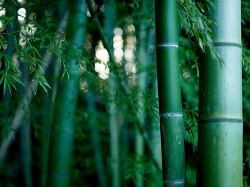
(Taken from Bamboo-Inspiration.com)
Bamboo construction makes use of the wide variety of building products now available that are made from one of the most versatile and sustainable building materials.
Bamboos are remarkably fast growing plants that thrive in a range of different climates.
Climates that stetch across the globe from northern Australia to East Asia, from India to the USA, Europe and Africa... and even Antarctica.
Bamboo construction makes use of the wide variety of building products now available that are made from one of the most versatile and sustainable building materials.
Bamboos are remarkably fast growing plants that thrive in a range of different climates.
Climates that stetch across the globe from northern Australia to East Asia, from India to the USA, Europe and Africa... and even Antarctica.
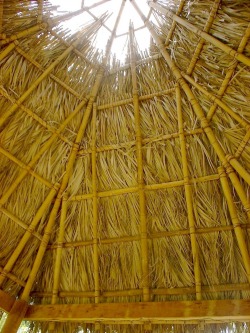
Because it is so strong it can be used as a structural material, and it's beauty provides an aesthetically pleasing finish.
In many parts of the world, particularly tropical climates where giant bamboos grow as forests, there is a tradition to using bamboos for constructing buildings and other structures.
These traditional methods can be particularly informative to the industry in other parts of the world where these products are becoming more widely used as we become more dependant on alternative and renewable materials.
As wood becomes more scarce bamboo construction will hold more and more value outside of the tropical climates where the benefits of its use have been known for centuries.
In many parts of the world, particularly tropical climates where giant bamboos grow as forests, there is a tradition to using bamboos for constructing buildings and other structures.
These traditional methods can be particularly informative to the industry in other parts of the world where these products are becoming more widely used as we become more dependant on alternative and renewable materials.
As wood becomes more scarce bamboo construction will hold more and more value outside of the tropical climates where the benefits of its use have been known for centuries.
